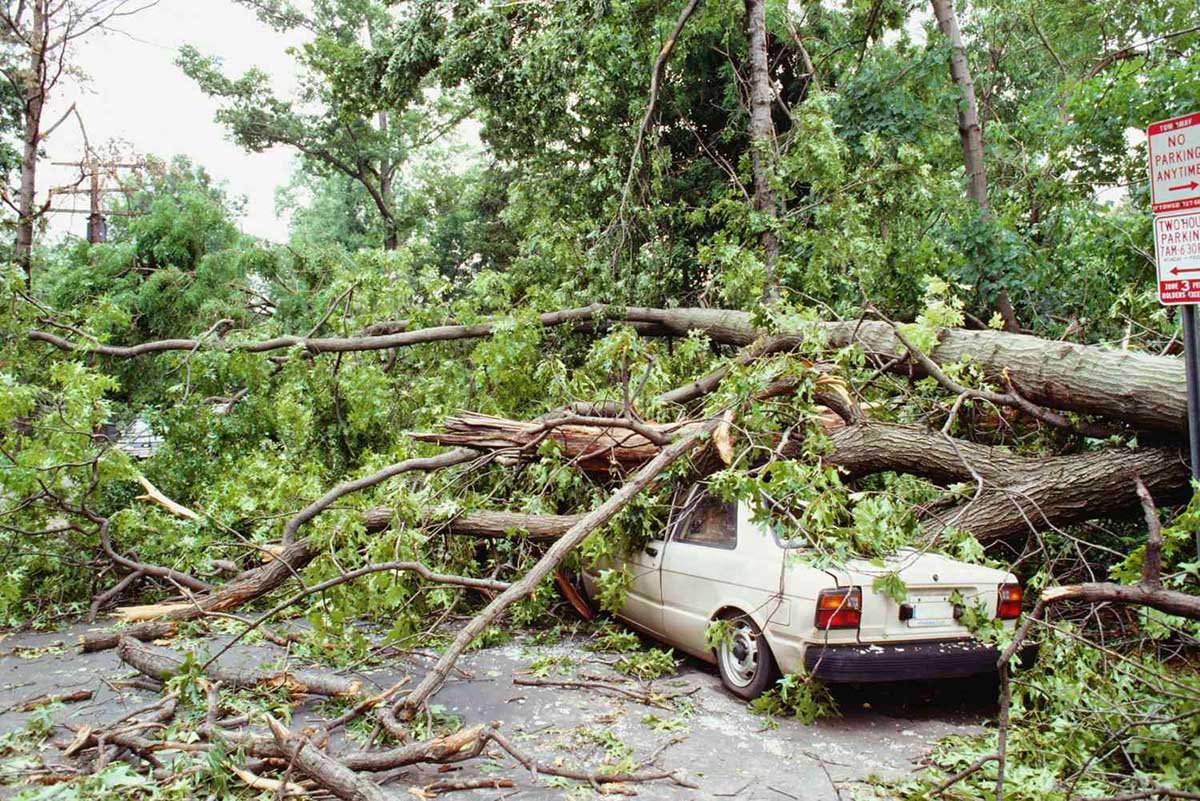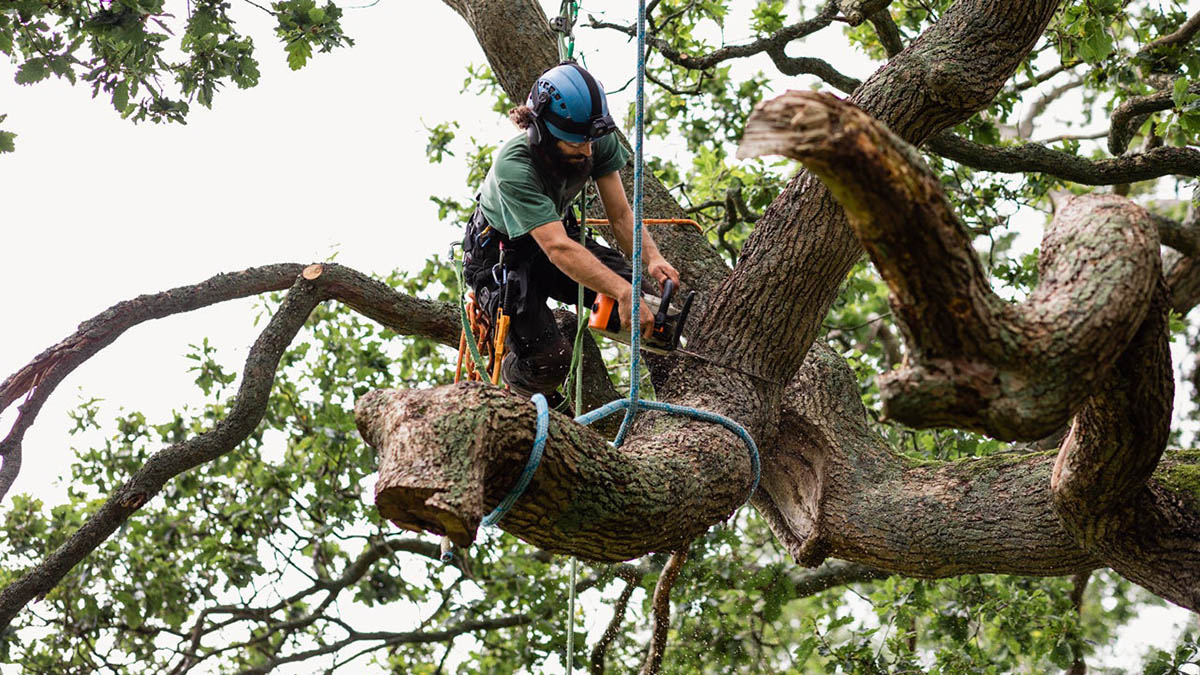Home>Finance>If A Tree Falls On Your Car, What Insurance Covers It?


Finance
If A Tree Falls On Your Car, What Insurance Covers It?
Published: November 16, 2023
Discover which insurance coverage can protect you financially if a tree damages your car. Learn about the finance aspect of insurance in such situations.
(Many of the links in this article redirect to a specific reviewed product. Your purchase of these products through affiliate links helps to generate commission for LiveWell, at no extra cost. Learn more)
Table of Contents
Introduction
Picture this: a stormy night, strong winds whipping through the air, and a large tree unexpectedly comes crashing down onto your parked car. You are left with a damaged vehicle and a sinking feeling in your chest. But don’t worry, you’re not alone in this unfortunate situation. Many people have faced similar circumstances, and understanding what insurance covers tree damage can help you navigate the aftermath with ease.
Dealing with auto insurance can be complex, and when it comes to damage caused by falling trees, the coverage can vary depending on the circumstances. Two main types of insurance policies may come into play in this situation: comprehensive auto insurance and homeowner’s insurance.
It’s crucial to understand the difference between these policies to determine which one will provide coverage for tree damage. Additionally, liability coverage can also play a role in covering damages that may occur to other people’s property if a tree falls from your property.
In this guide, we’ll outline the key aspects of these insurance coverages and provide insights on how to navigate the claims process. We’ll also discuss deductibles and the steps you should take to file a claim successfully.
While we can’t prevent trees from falling, understanding your insurance coverage can help alleviate some of the stress and financial burden that comes with unexpected accidents. So, let’s delve into the details of tree damage insurance coverage and empower you to effectively navigate this situation.
Understanding Tree Damage Insurance Coverage
When it comes to insurance coverage for tree damage, it’s essential to understand how different policies come into play. Let’s take a closer look at the various types of coverage that may apply in this situation.
Comprehensive Auto Insurance: Comprehensive auto insurance is designed to cover damage to your vehicle that occurs as a result of events other than collisions with other vehicles. This can include damage from falling objects, such as trees. If a tree falls on your car, comprehensive coverage may provide the financial assistance you need to repair or replace your vehicle.
Homeowner’s Insurance: Your homeowner’s insurance policy may also provide coverage for tree damage, but with some limitations. Typically, homeowner’s insurance covers damage to structures such as your house or garage caused by falling trees. However, coverage for damage to vehicles may be limited or excluded. It’s crucial to review your policy or speak with your insurance provider to understand the extent of your coverage.
Liability Coverage: Liability coverage comes into play when a tree from your property falls and damages someone else’s property. For example, if a tree from your yard falls onto your neighbor’s car, your liability coverage may cover the expenses of repairing or replacing their vehicle. It’s important to note that liability coverage usually has limits, so it may not cover the full cost of the damages.
In some cases, the responsibility for tree damage may be determined by negligence. If it is found that you were aware of a dead or dangerous tree on your property and failed to take action to remove it, this could impact your insurance coverage and liability.
It’s essential to carefully review your insurance policies to understand the coverage they provide for tree damage. If you have any questions or uncertainties, reach out to your insurance agent or provider for clarification. They can guide you through the specifics of your policy and help you navigate the claims process if necessary.
Now that we have a better understanding of the types of insurance coverage that may apply to tree damage, let’s explore the details of comprehensive auto insurance and homeowner’s insurance in more depth.
Comprehensive Auto Insurance
Comprehensive auto insurance is an optional coverage that protects you against a wide range of perils that can damage your vehicle. While it’s not required by law, it provides valuable protection beyond basic liability coverage.
When it comes to tree damage, comprehensive auto insurance is the primary policy that covers repairs or replacement of your vehicle if a tree falls on it. This coverage extends to a variety of other scenarios, including damages caused by hail, vandalism, theft, and more.
Under a comprehensive auto insurance policy, the insurance company will assess the extent of the damage caused by the fallen tree. If the vehicle is repairable, the insurance company will typically cover the cost of repairs, up to the actual cash value (ACV) of the car.
If the vehicle is deemed a total loss due to severe damage, the insurance company will offer a settlement based on the ACV of the vehicle at the time of the incident. The ACV is determined by considering factors such as the age of the vehicle, its condition, and market value.
It’s important to note that comprehensive coverage typically comes with a deductible. The deductible is the amount you are responsible for paying out-of-pocket before the insurance company starts covering the costs. For example, if your deductible is $500 and the total repair cost is $3,000, you will need to pay the $500 deductible, and the insurance company will cover the remaining $2,500.
Review your comprehensive auto insurance policy to understand the specifics of the coverage, including the deductible amount and any additional limits or exclusions. It’s also a good idea to reassess your policy periodically to ensure that it aligns with your current needs and expectations.
Now that we’ve explored comprehensive auto insurance coverage, let’s shift our focus to homeowner’s insurance and its role in tree damage incidents.
Homeowner’s Insurance
Homeowner’s insurance provides coverage for your home and personal property in the event of certain perils, including tree damage. While homeowner’s insurance primarily focuses on protecting the physical structure of your home, it may also provide some coverage for damages caused by trees.
When it comes to tree damage, homeowner’s insurance generally covers the cost of repairs if a fallen tree damages the structure of your home, such as your house, garage, or other buildings on your property. This coverage may also extend to other structures on your property, such as fences or sheds.
However, it’s important to note that homeowner’s insurance may have limitations or exclusions when it comes to coverage for damages to vehicles caused by falling trees. Coverage for vehicles is typically more comprehensive under an auto insurance policy.
It’s crucial to review your homeowner’s insurance policy and speak with your insurance provider to understand the extent of your coverage for tree damage. Make sure to clarify any exclusions or limitations that may apply. If damage to your vehicle is not covered under your homeowner’s policy, you’ll need to rely on your comprehensive auto insurance for assistance.
Remember, homeowner’s insurance is designed to protect the structure of your home and your personal property within it. To ensure that you’re adequately covered for tree damage, it’s essential to have a clear understanding of the coverage provided by both your homeowner’s insurance and your comprehensive auto insurance.
Next, let’s explore the concept of liability coverage and its role in tree damage incidents.
Liability Coverage
Liability coverage is an important component of both auto and homeowner’s insurance policies. It provides protection if you are found responsible for causing damage to someone else’s property, including damage caused by a fallen tree from your property.
When it comes to tree damage incidents, liability coverage may come into play if a tree from your property falls onto your neighbor’s car, causing damage. In this situation, your liability coverage may help cover the costs of repairing or replacing the damaged vehicle.
However, it’s crucial to note that liability coverage typically has limits. These limits represent the maximum amount that the insurance company will pay for damages. If the cost of the damages exceeds your liability coverage limit, you may be responsible for the remaining expenses.
It’s important to review your liability coverage limits and ensure that they are adequate to protect you in the event of a tree damage incident. If you anticipate that the potential damage caused by a fallen tree could exceed your liability coverage limit, you may want to consider increasing your coverage.
Additionally, it’s essential to understand that liability coverage is typically intended to cover damages to other people’s property and not your own. In the case of tree damage to your own vehicle, your comprehensive auto insurance will be the primary coverage to consider.
If you are involved in a tree damage incident, it’s essential to report the incident to your insurance company promptly. They will guide you through the claims process and help determine the coverage applicable to your specific situation.
Now that we have covered the main types of insurance coverage related to tree damage, let’s delve into the topic of deductibles and their role in the claims process.
Deductibles
When it comes to insurance coverage, deductibles are an important aspect to consider. A deductible is the amount of money you are responsible for paying out-of-pocket before your insurance coverage kicks in.
Both comprehensive auto insurance and homeowner’s insurance typically have deductibles associated with them. The specific deductible amount can vary depending on your policy and the choices you made when selecting coverage.
When a tree falls on your car or causes damage to your property, you will need to pay the deductible before your insurance company covers the remaining costs. For example, if you have a $500 deductible and the total repair cost is $5,000, you’ll need to pay the $500 deductible, and the insurance company will cover the remaining $4,500.
It’s important to review and understand the deductible amounts stated in your insurance policies. Keep in mind that higher deductible amounts often result in lower premium rates, but it also means you’ll have a higher out-of-pocket expense in the event of a claim.
Consider your financial situation and assess the risk involved when setting your deductible. If you have the means to comfortably cover a higher deductible, it may be worth opting for a higher amount to lower your premiums. On the other hand, if a high deductible would cause significant financial strain, it might be wise to choose a lower deductible.
Remember to consult with your insurance agent or provider to discuss the deductible options available to you and determine the most suitable choice for your circumstances.
Now that we understand the role of deductibles, let’s move on to the final section of this guide: filing a claim.
Filing a Claim
When facing tree damage to your car or property, it’s crucial to know how to effectively file an insurance claim. Following the proper steps can help ensure a smooth and efficient claims process. Here are the key steps to consider:
1. Document the damage: Before you begin the claims process, gather evidence of the tree damage. Take photos of the damage to your car or property, including any visible marks or destruction. These photos will serve as crucial evidence during the claims process.
2. Contact your insurance provider: Reach out to your insurance company to report the incident and initiate the claims process. Provide them with the necessary details, including the date, time, and location of the incident, as well as any relevant documentation or photos you have gathered.
3. Follow the instructions provided: Your insurance provider will guide you through the claims process and provide you with specific instructions on what information they require from you. It’s important to follow these instructions carefully to ensure a smooth and efficient claims process.
4. Provide relevant documentation: Your insurance company may ask you to fill out claim forms and provide additional documentation, such as a police report, if applicable. Be sure to gather and submit all the necessary documents promptly to avoid any delays in processing your claim.
5. Cooperate with the claims adjuster: In some cases, an insurance adjuster may need to assess the extent of the damages. Cooperate with the adjuster and provide them with access to your vehicle or property as needed. Their evaluation will help determine the coverage and reimbursement for the damages.
6. Keep records: Throughout the claims process, keep detailed records of any communication with your insurance company, including dates, names of representatives, and a summary of the conversation. This information will be helpful for future reference and resolving any potential issues that may arise.
7. Understand the settlement offer: Once your claim is processed, your insurance company will provide a settlement offer based on the coverage and assessment of the damages. Review the offer carefully, including any deductions for deductibles or other applicable fees, and ask questions if anything is unclear.
8. Complete the necessary paperwork: If you agree to the settlement offer, you will need to complete the necessary paperwork to finalize the claim. This may include signing a release form or other documentation as required by your insurance company.
9. Repair or replace: With the claim settled, you can proceed with repairing or replacing your vehicle or property. Depending on the terms of your policy and the settlement, you may need to choose from approved repair shops or follow specific guidelines provided by your insurance company.
Remember to stay in communication with your insurance provider throughout the entire claims process. They are there to assist you and answer any questions or concerns you may have along the way.
Now that you have a clear understanding of how to file a claim, let’s summarize the key points discussed in this guide.
Conclusion
Dealing with tree damage to your car or property can be a distressing experience, but understanding your insurance coverage can help ease the burden. By being aware of the different types of insurance policies that can come into play, you can ensure you have the necessary protection in place.
Comprehensive auto insurance is the primary coverage to consider for repairing or replacing your vehicle if a tree falls on it. Homeowner’s insurance may provide coverage for damages to the structure of your home caused by fallen trees, but coverage for vehicles may be limited. Liability coverage can also play a role if a tree from your property damages someone else’s property.
It’s crucial to review your insurance policies, understand the deductibles associated with them, and consider any potential coverage limitations or exclusions. This information will help you make informed decisions and ensure you have the appropriate coverage for any tree damage incidents.
In the event of tree damage, the claims process is an important step to navigate. By documenting the damage, contacting your insurance provider, providing necessary documentation, and cooperating with the claims adjuster, you can ensure a smooth and efficient claims process. Keeping records and understanding the settlement offer are also key components of successfully filing a claim.
Remember to reach out to your insurance agent or provider if you have any questions or need guidance during the claims process. They are there to assist you and provide the necessary support to expedite your claim.
While we can’t predict when a tree might fall, having the right insurance coverage and knowledge of the claims process will give you peace of mind and financial protection in the face of unexpected incidents.
Stay informed, review your policies regularly, and be prepared, so that if a tree should ever fall on your car, you’ll know exactly what insurance covers it.














